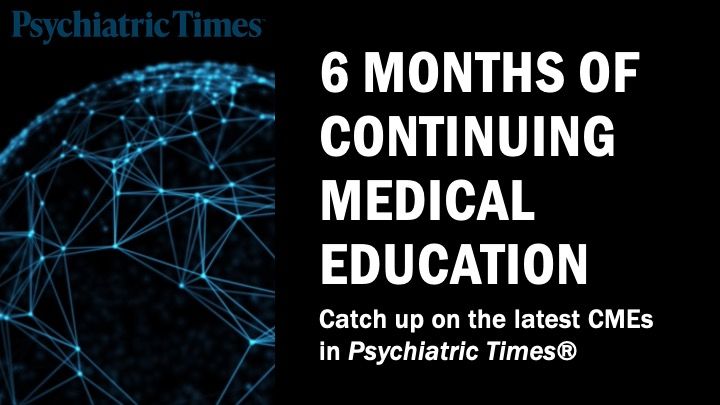Publication
Article
Psychiatric Times
Debating the One-third Rule
Dr Stark's article, "Neurotransmitters, Pharmacologic Synergy, and Clinical Strategies" ( Psychiatric Times , October 2006 Special Edition, page 1) offered a refreshing and sober discussion about the difficulties in treating psychiatric illnesses with the therapies that are currently available. The point regarding the error of adopting a "too-narrow focus on imbalanced neurotransmitter levels" without considering the "contributions of other biochemical and physiologic factors to the overall picture" was especially relevant. However, despite the inherent appeal of the holistic model of treatment, the practical adoption of its principles in the treatment of psychiatric patients may remain a guessing game for some time.
Dr Stark's article, "Neurotransmitters, Pharmacologic Synergy, and Clinical Strategies" ( Psychiatric Times, October 2006 Special Edition, page 1) offered a refreshing and sober discussion about the difficulties in treating psychiatric illnesses with the therapies that are currently available. The point regarding the error of adopting a "too-narrow focus on imbalanced neurotransmitter levels" without considering the "contributions of other biochemical and physiologic factors to the overall picture" was especially relevant. However, despite the inherent appeal of the holistic model of treatment, the practical adoption of its principles in the treatment of psychiatric patients may remain a guessing game for some time.
One of the difficulties is that to date there is little clinically useful knowledge about the precise ways in which disruptions in the immune system and the brain-end organ endocrine axis cause psychiatric pathology, and even less information about what steps are to be taken to restore homeostasis in the form of mental balance. The issue of emotional and cognitive resilience, which probably involves numerous variables (of which physiological homeostatic regulation may be one), remains poorly understood.
Dr Stark may very well be on the right track when she suggests that homeostatic mechanisms as well as the medications' biochemical actions, including hormesis, combine in certain ways to produce the desired therapeutic effect, or lack thereof, as the case may be. The fly in the ointment is that each patient's clinical condition represents a unique combination of multiple degrees of freedom in an equation that is probably far more complicated than we suspect. Today there is no way to answer the question of why one premenopausal patient with diabetes mellitus and compensated hypothyroidism responds to a 10-mg dose of fluoxetine (Prozac) while another requires 40 mg, and yet another fails to respond to anything but electroconvulsive therapy.
Hormesis and synergy, terms that in principle may apply to the treatment of every patient may, nevertheless, apply in ways that are highly idiosyncratic. Understanding these idiosyncrasies is highly desirable but difficult to investigate in the sort of large, placebo-controlled, double-blind studies on which we have rightly or wrongly relied for learning whether medicines work. Until we have at least a somewhat better appreciation for how the sort of internal physiological variables of which Dr Stark speaks in her article combine with medication effects in individual patients, we may have to continue to rely on the rule of thirds that many of us continue to use in clinical practice with some embarrassment, resignation, and yes, tongue in cheek.
Boris Vatel, MD
Evansville, Ind
Dr Vatel is a staff psychiatrist at Evansville State Hospital in Indiana.
Dr Stark responds:
Dr Vatel's point is indeed well taken, namely, that it's all well and good to conceive of the patient in holistic terms as a synergy of regulatory systems responsible for maintaining overall homeostatic balance-but that to operationalize such an approach is easier said than done.
In addition, if we throw into the mix every patient's genetic uniqueness and biochemical individuality (the patient's "contribution") and the possible hormetic, or biphasic, effects of the medication (the drug's "contribution"), the plot thickens even further! So-called treatment resistance becomes a story about not only the patient but also the intervention and, by extension, the practitioner.
More generally, the overwhelming multiplicity of factors that we must take into consideration in each situation makes it well nigh impossible to predict the efficacy of any particular intervention, let alone prove efficacy by way of randomized, double-blind, placebo-controlled trials-the gold standard of outcome studies. Confusingly, but compellingly, every person is a nonlinear dynamic system and the impact of every medication trial, although not entirely random, is most certainly not entirely knowable in advance. It is truly humbling for even the most seasoned psychopharmacologist and certainly for me (a psychoanalyst). Small wonder that we find our patients often "resistant" to our most sincere efforts to improve their mental health by way of adjusting the levels of neurotransmitters in their brains!
It is sad to say, but the state of our psychopharmacological art is still in its infancy. We are only beginning to recognize the complex interplay of the various systems responsible for regulating the constancy of the body's internal environment and, therefore, the patient's emotional and physical well-being; we are only beginning to appreciate that an imbalance in one part of the patient will inevitably affect the optimal functioning of all the patient's other interconnected parts. Indeed, until we know more about the interdependence of the mind and body and their various regulatory systems and feedback loops, we may, by default, have to settle for a "one size fits all" treatment approach and be prepared to accept the sometimes rather disappointing results.
With that said, my fervent hope is that we-medically trained practitioners that we all are-will find ourselves open to broadening our horizons so that we can learn about the potential impact of psychological, biochemical, physiological, and energetic stressors on our mental states. This impact ranges from (1) the slowing of our vital processes occasioned by the easily determined low-body temperatures that so often accompany clinical and, even, subclinical hypothyroidism (about which Dr Joffe, one of the contributors to the October 2006 Special Edition, 1 and others have written) to (2) the less-than-optimal utilization of the body's nutrient reserves occasioned by improper pH balance in the body's extracellular matrix (which is reasonably accurately assessed by way of a simple salivary pH test) to (3) the sluggishness of our thought processes and our generally depressed moods when we are dehydrated because we have not been consuming the requisite 6 to 10 glasses of water per day to (4) the devastating impact of emotional and environmental stressors to which the mind and body are being continuously exposed.
While it may seem overwhelming to contemplate the multitude of potential contributors to diminished vitality and psychological distress, my article was intended as a plea for less reductionism and less insularity in our field and for the implementation of at least a somewhat more holistic, more systemic, and more integrative approach to mental health.
If we are ever to improve on the one-third rule, then, as anxiety-provoking as it might be, we must humbly accept the limits of our current knowledge. In addition, we must invite newer perspectives; develop a broader understanding of the synergistic impact of the many variables that influence both mind and body; and learn to tolerate the discomfort that comes with not always knowing "the answer." Further, we must also do the very best we can to appreciate that our patients are breathtakingly complex and extraordinarily unique individuals who want nothing more than for us to bring to the consultation room the best of who we are and the best of what we are coming to know.
Martha Stark, MD
Boston
Dr Stark is clinical instructor in psychiatry, Harvard Medical School, department of continuing education, Beth Israel Deaconess Medical Center, and adjunct faculty, Center for Psychoanalytic Studies, Massachusetts General Hospital, in Boston. She is also the author of several books on resistance and the modes of therapeutic action.
References:
Reference1. Joffe R. Augmentation strategies in treatment- resistant depression. Psychiatric Times. 2006;23(12): 9-13.





